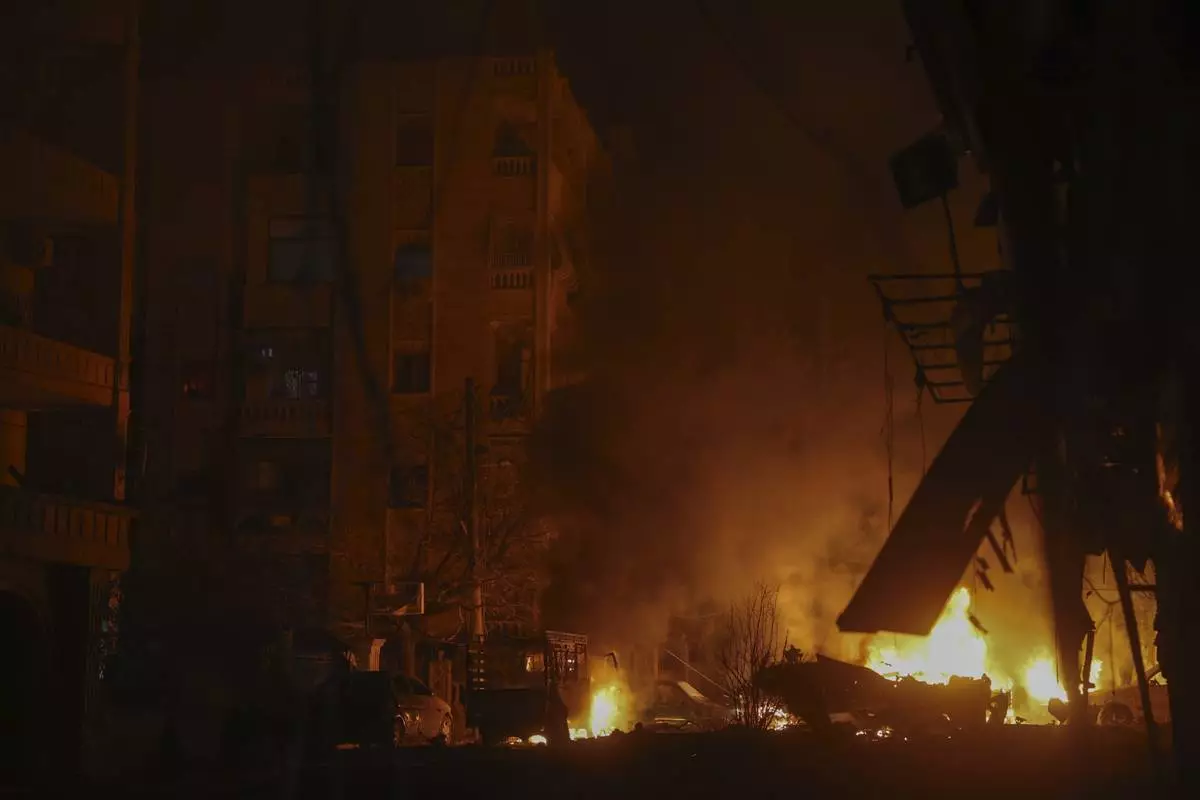SANTA BARBARA, Calif.--(BUSINESS WIRE)--Dec 2, 2024--
At the 2024 MRS Fall Meeting & Exhibit, Bruker Corporation (Nasdaq: BRKR) today announced the launch of the Dimension Nexus™ atomic force microscope (AFM). Dimension Nexus is the newest addition to the industry-leading Dimension® AFM product line, which has had more than 4600 systems installed around the world. With the latest-generation NanoScope® 6 controller, this new small-footprint AFM delivers wider access to Bruker’s exclusive PeakForce Tapping® technology and over 50 AFM modes. The upgradability and enhanced ease of use of DimensionNexus provides an optimal intersection of performance and value for the evolving needs of both growing labs and multi-user facilities.
This press release features multimedia. View the full release here: https://www.businesswire.com/news/home/20241202516581/en/
“We already have a number of Bruker AFMs in our open-access user facilities and are always looking for new technology that can further support the many researchers we serve from both academia and industry,” said Dr. Alice Pyne, Head of the Henry Royce Nanocharacterisation Laboratory at the University of Sheffield. “I especially appreciate the compact and upgradable nature of the Dimension Nexus large-sample AFM, and the fact that it can perform the latest PeakForce Tapping modes. I can see this being a real advantage for multi-user labs, where AFM expertise and applications vary, and where physical space for instruments is at a premium.”
“With the release of Nexus, we have taken a significant step in making the very latest AFM technology available to a wider research community,” added Thomas Mueller, Senior Director of AFM Instrumentation at Bruker. “Its combination of data quality, performance, and versatility make it both an excellent starter AFM and a perfect addition to a thriving AFM lab.”
About Dimension Nexus
Taking advantage of decades of AFM innovation, Dimension Nexus delivers exceptional value. Its open-architecture system with low drift and low noise enables researchers to collect high-quality data for both routine and custom experiments. The high-speed NanoScope 6 controller, combined with Bruker’s exclusive ScanAsyst® technology, ensures unprecedented ease of use. This small-footprint, versatile system boosts productivity with a programmable stage for high-throughput multi-site analysis. Additionally, Dimension Nexus supports a wide array of unique modes, such as AFM-nDMA for viscoelastic measurements, PeakForce QNM® for high-resolution quantitative mapping of mechanical properties, and DataCube modes for hyperspectral imaging.
About Bruker Corporation – Leader of the Post-Genomic Era
Bruker is enabling scientists and engineers to make breakthrough post-genomic discoveries and develop new applications that improve the quality of human life. Bruker’s high performance scientific instruments and high value analytical and diagnostic solutions enable scientists to explore life and materials at molecular, cellular, and microscopic levels. In close cooperation with our customers, Bruker is enabling innovation, improved productivity, and customer success in post-genomic life science molecular and cell biology research, in applied and biopharma applications, in microscopy and nanoanalysis, as well as in industrial and cleantech research, and next-gen semiconductor metrology in support of AI. Bruker offers differentiated, high-value life science and diagnostics systems and solutions in preclinical imaging, clinical phenomics research, proteomics and multiomics, spatial and single-cell biology, functional structural and condensate biology, as well as in clinical microbiology and molecular diagnostics. For more information, please visit www.bruker.com.


The Dimension Nexus atomic force microscope (right) with the latest-generation NanoScope 6 controller (left) (Photo: Business Wire)
WASHINGTON (AP) — The 13-year civil war in Syria has roared back into prominence with a surprise rebel offensive during which they seized Aleppo, one of Syria's largest cities and an ancient business hub. The push is among the rebels' strongest in years in a war whose destabilizing effects have rippled far beyond the country's borders.
It was the first opposition attack on Aleppo since 2016, when a brutal air campaign by Russian warplanes helped Syrian President Bashar Assad retake the northwestern city. Intervention by Russia, Iran and Iranian-allied Hezbollah and other groups had allowed Assad to remain in power within the 70% of Syria under his control.
Insurgents led by jihadi group Hayat Tahrir al-Sham launched the two-pronged attack on Aleppo last week and moved into the countryside around Idlib and neighboring Hama province. The Syrian military has rushed reinforcements and launched airstrikes as they attempted to stall their momentum.
The surge in fighting has raised the prospect of another violent front reopening in the Middle East, at a time when U.S.-backed Israel is fighting Hamas in Gaza and Hezbollah in Lebanon, both Iranian-allied groups.
Robert Ford, the last-serving U.S. ambassador to Syria, pointed to months of Israeli strikes on Syrian and Hezbollah targets in the area, and to Israel’s ceasefire with Hezbollah in Lebanon last week, as factors providing Syria’s rebels with the opportunity to advance. Russia, Assad's main international backer, is also preoccupied with its war in Ukraine.
Here's a look at some of the key aspects of the new fighting:
Assad has been at war with opposition forces seeking his overthrow for 13 years, a conflict that's killed an estimated half-million people. The conflict started as one of the Arab Spring popular uprisings in 2011 against Arab dictators, before Assad's brutal response to what had been largely peaceful protests turned the conflict violent. Some 6.8 million Syrians have fled the country since then, a refugee flow that helped change the political map in Europe by fueling anti-immigrant far-right movements.
The roughly 30% of the country not under Assad is controlled by a range of opposition forces and foreign troops. The U.S. has about 900 troops in northeast Syria, far from Aleppo, to guard against a resurgence by the Islamic State. Both the U.S. and Israel conduct occasional strikes in Syria against government forces and Iran-allied militias. Turkey has forces in Syria as well, and has influence with the broad alliance of opposition forces storming Aleppo.
Coming after years with few sizeable changes in territory between Syria's warring parties, the fighting “has the potential to be really quite, quite consequential and potentially game-changing,” if Syrian government forces prove unable to hold their ground, said Charles Lister, a longtime Syria analyst with the U.S.-based Middle East Institute.
Risks include if militants with the Islamic State extremist group see the renewed fighting as an opening, Lister said. The Islamic State, a violently anti-Western and repressive organization, in 2014 notoriously declared a self-styled caliphate that seized parts of Syria and Iraq. The Islamic State's Syria and Iraq branch no longer controls any territory, and is not known to be playing a role in the current fighting. But is still a lethal force operating through sleeper cells in the two countries.
Ford said the fighting in Aleppo would become more broadly destabilizing if it drew Russia and Turkey — each with its own interests to protect in Syria — into direct heavy fighting against each other.
The U.S. and U.N. have long designated the opposition force leading the attack at Aleppo — Hayat Tahrir al-Sham, known by its initials HTS — as a terrorist organization.
Abu Mohammed al-Golani emerged as the leader of al-Qaida's Syria branch in 2011, in the first months of Syria's war. It was an unwelcome intervention to many in Syria's opposition, who hoped to keep the fight against Assad's brutal rule untainted by violent extremism.
Golani and his group early on claimed responsibility for deadly bombings, pledged to attack Western forces, confiscated property from religious minorities and sent religious police to enforce modest dress by women.
Golani and HTS have sought to remake themselves in recent years, focusing on promoting civilian government in their territory as well as military action, researcher Aaron Zelin noted. His group broke ties with al-Qaida in 2016. Golani cracked down on some extremist groups in his territory, and increasingly portrays himself as a protector of other religions. That includes last year allowing the first Christian Mass in the city of Idlib in years.
By 2018, the Trump administration acknowledged it was no longer directly targeting Golani, Zelin said. But HTS has allowed some wanted armed groups to continue to operate on its territory, and shot at U.S. special forces at least as recently as 2022, he said.
At the crossroads of trade routes and empires for thousands of years, Aleppo is one of the centers of commerce and culture in the Middle East.
Aleppo was home to 2.3 million people before the war. Rebels seized the east side of the city in 2012, and it became the proudest symbol of the advance of armed opposition factions.
In 2016, government forces backed by Russian airstrikes laid siege to the city. Russian shells, missiles and crude barrel bombs — fuel canisters or other containers loaded with explosives and metal — methodically leveled neighborhoods. Starving and under siege, rebels surrendered Aleppo that year.
The Russian military's entry was the turning point in the war, allowing Assad to stay on in the territory he held.
This year, Israeli airstrikes in Aleppo have hit Hezbollah weapons depots and Syrian forces, among other targets, according to an independent monitoring group. Israel rarely acknowledges strikes at Aleppo and other government-held areas of Syria.

A defaced portrait of Syrian President Bashar Assad lies on the ground in the town of Maarat al-Numan, southwest from Aleppo, Syria, Saturday Nov. 30, 2024. Thousands of Syrian insurgents have fanned out inside Syria's largest city Aleppo and large areas around previously controlled by the government with little resistance from troops.(AP Photo/Omar Albam)

Syrian opposition fighters drive by an abandoned Syrian army armoured vehicle on a highway in the outskirts of in Khan Sheikhoun, southwest of Aleppo, Sunday, Dec. 1, 2024. Syrian opposition insurgency launched a campaign on Wednesday with a two-pronged attack on Aleppo and the countryside around Idlib.(AP Photo/Ghaith Alsayed)

Syrian opposition fighters drive a seized seized Syrian army armoured vehicle near the town of Khan Assubul, Syria, southwest of Aleppo, Sunday, Dec. 1, 2024. Syrian opposition insurgency launched a campaign on Wednesday with a two-pronged attack on Aleppo and the countryside around Idlib.(AP Photo/Ghaith Alsayed)

The bodies of Syrian army soldiers and allied fighters lie next to a Syrian army vehicle after being allegedly killed in combat by opposition fighters in Aleppo, Syria, early Saturday Nov. 30, 2024. Thousands of Syrian insurgents have fanned out inside Syria's largest city Aleppo a day after storming it with little resistance from government troops.(AP Photo/Omar Albam)

Vehicles burn after an airstrike against opposition fighters in Aleppo, Syria, late Friday, Nov. 29, 2024. (AP Photo/Ghaith Alsayed)

Syrian opposition fighters ride in a truck in Talhiya, Idlib countryside, Syria, Friday, Nov. 29, 2024. (AP Photo/Ghaith Alsayed)

Opposition forces take control of areas outside Aleppo, Syria, Friday, Nov. 29, 2024. (AP Photo/Ghaith Alsayed)

Opposition forces take control of areas outside Aleppo, Syria, Friday, Nov. 29, 2024. (AP Photo/Ghaith Alsayed)



















